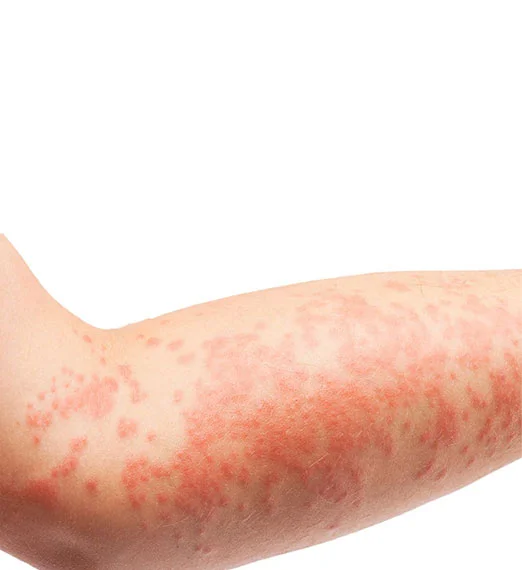Skin allergies can affect anyone!
Are you experiencing it? Then here is the guide to eczema skin allergy and autoimmune skin diseases in Bangalore by skin expert Dr. Rajdeep Mysore at Charma Clinic.
What is eczema and atopic dermatitis?
Eczema is a persistent skin condition that manifests as dry, red, itchy, and sometimes infected skin. It is a general medical term referring to rash-like skin conditions. It can affect people of any age, but mostly the babies. Those who have eczema like atopic dermatitis experience a period of worsening of eczema followed by a period of skin healing or clearing up of eczema. The remission periods are times when no symptoms of eczema are noticed. These times can last for a few weeks, months, and even years. When eczema exacerbates, it’s called an eczema flare. Eczema flare is an outcome of a range of skin irritants or triggers. Eczema can show up in different forms. Each type has its own set of triggers and symptoms.
Atopic dermatitis is the most common type of eczema, which is why many people refer eczema to as atopic dermatitis. The term “Atopic” means a form of allergy in which hypersensitivity reactions like eczema, hay fever, and asthma occurs. “Dermatitis” is a general term for red, inflamed, and itchy skin. Atopic dermatitis is the result of an allergic reaction that usually starts at the time of infancy and continues into childhood. Flare-ups of atomic dermatitis in adults tend to get milder or resolve.
As the condition can affect one’s overall health it is important to take help of a dermatologist. At Charma Clinic, eczema treatment clinic in Bangalore, Dr. Rajdeep Mysore has helped many patients suffering from eczema to lead a healthy life with best eczema treatments.
What causes atopic dermatitis and other eczemas?
The definite cause of atopic dermatitis and eczema remains still under research. However, the possible triggers of different types of eczema are:
1. Atopic Dermatitis- It happens when the natural skin barrier gets weak and is not able to protect the skin much from allergens and irritants. Its causative factors include environmental triggers, dry skin, genetic predisposition, and a weakened immune system.
2. Contact Dermatitis- It is an immune response to contact skin with an irritant or allergen. Most commonly, it is caused due to exposure of skin to latex, detergents, bleach, jewellery, nickel, paint, solvents, tobacco smoke, skincare products including makeup, poisonous ivy or other toxic plants, and soaps and perfumes.
3. Dyshidrotic Eczema- It can be caused by stress, allergies, damp hands and feet, smoking tobacco products, and nickel, chromium salt, or cobalt exposure. It is mostly seen in women.
4. Neurodermatitis- Usually, it is seen in people who have other types of eczema or psoriasis. Its cause is still not known to doctors. But, stress is found to trigger its appearance.
5. Seborrheic Dermatitis- It can be caused by a combination of genetic and environmental factors. Triggers like stress or some illness can spark off the skin’s inflammatory reaction that can boost sebum (natural oil) production by sebaceous glands. Malasezzia yeast thrives on excessively oily skin.
6. The overgrowth of this yeast can cause immune system reactions that further cause skin changes and the development of seborrheic dermatitis. Other triggers are cold, dry weather; hormonal changes, illnesses, use of harsh chemicals or detergents, medications containing lithium and in-ter-fe-ron, and certain medical conditions like HIV, acne, psoriasis, and Parkinson’s disease.
7. Stasis Dermatitis- It is caused by the leakage of fluids from weakened veins into the skin. It is seen in people suffering from valve malfunction causing blood flow problems in their lower legs.
8. Nummular Eczema- It is triggered by an allergic reaction to chemicals or metals, dry skin, or a reaction to an insect bite.
9. Hand Eczema- It is the type that affects only the hands of an individual who is working as a hairdresser or has a regular job where hands are needed for cleaning. This eczema is the result of regular use of skin-irritating chemicals.


